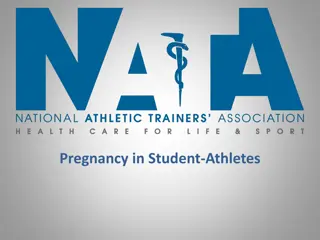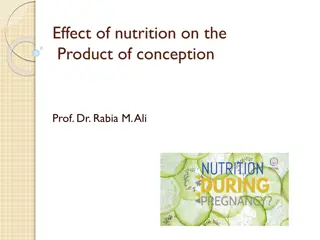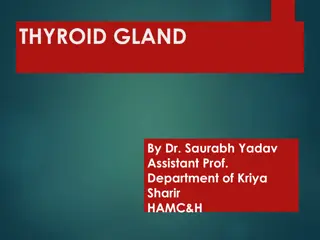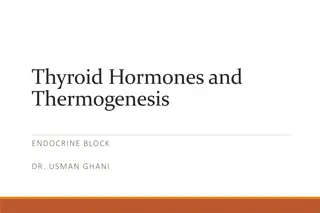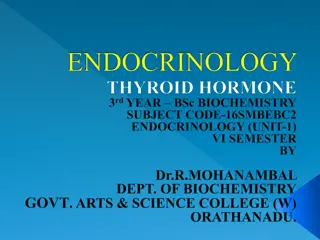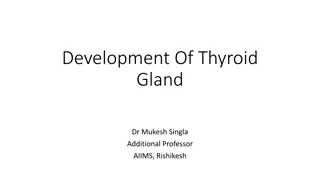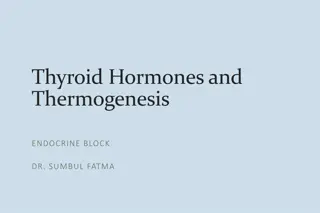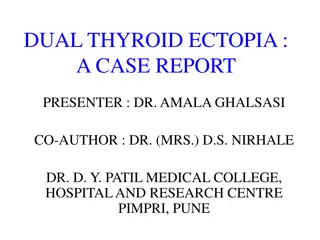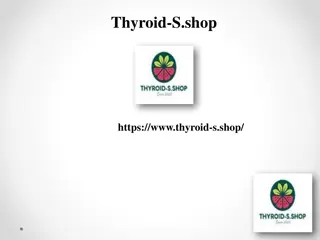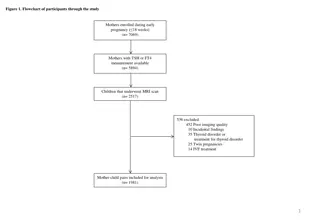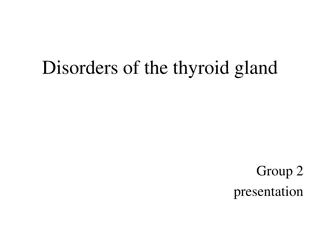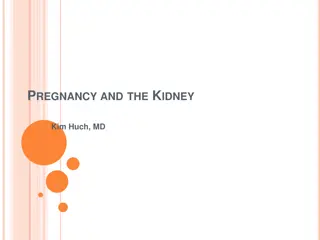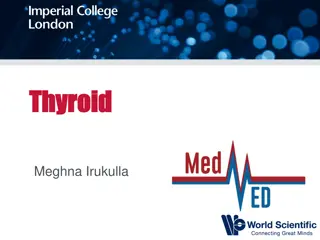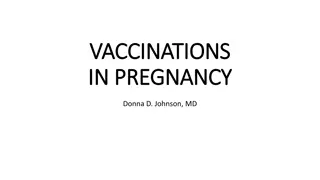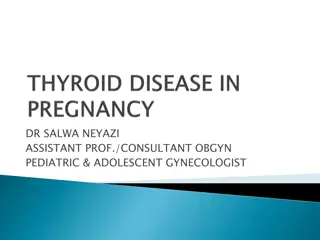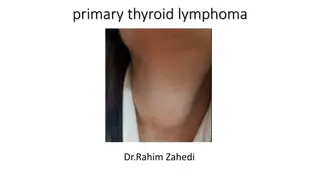
Thyroid Function Changes During Pregnancy: Guidelines and Recommendations
Explore the impact of pregnancy on thyroid function, including changes in thyroid hormone levels, testing procedures, and normal reference ranges for TSH concentrations in each trimester. These guidelines from the American Thyroid Association provide valuable insights for managing thyroid disease during pregnancy and the postpartum period.
Download Presentation

Please find below an Image/Link to download the presentation.
The content on the website is provided AS IS for your information and personal use only. It may not be sold, licensed, or shared on other websites without obtaining consent from the author. If you encounter any issues during the download, it is possible that the publisher has removed the file from their server.
You are allowed to download the files provided on this website for personal or commercial use, subject to the condition that they are used lawfully. All files are the property of their respective owners.
The content on the website is provided AS IS for your information and personal use only. It may not be sold, licensed, or shared on other websites without obtaining consent from the author.
E N D
Presentation Transcript
2017 Guidelines of the American Thyroid Association for the Diagnosis and Management of Thyroid Disease during Pregnancy and the Postpartum
I. Introduction Pregnancy has a profound impact on the thyroid gland and its function. During pregnancy, the thyroid gland increases in size by 10% in iodine replete countries, but by 20% to 40% in areas of iodine deficiency. Production of the thyroid hormones, thyroxine (T4) and triiodothyronine (T3), increases by nearly 50%, in conjunction with a separate 50% increase in the daily iodine requirement. These physiological changes happen seamlessly in healthy women, but thyroid dysfunction can occur in many pregnant women due to pathologic processes.
III. Thyroid Function Testing and Pregnancy QUESTION 1 -HOW DO THYROID FUNCTION TESTS CHANGE DURING PREGNANCY?
Normal pregnancy is associated with an increase in renal iodine excretion, an increase in thyroxine binding proteins, an increase in thyroid hormone production, and thyroid stimulatory effects of hCG. All of these factors influence thyroid function tests in the pregnant patient.
Following conception, circulating thyroxine binding globulin (TBG) and total T4 (TT4) concentrations increase by week 7 of gestation, and reach a peak by approximately week 16 of gestation. These concentrations then remain high until delivery.
QUESTION 2 - WHAT IS THE NORMAL REFERENCE RANGE FOR SERUM TSH CONCENTRATIONS IN EACH TRIMESTER OF PREGNANCY?
There is a downward shift of the TSH reference range during pregnancy, with a reduction in both the lower (decreased by about 0.1-0.2 mU/L) and the upper limit of maternal TSH (decreased by about 0.5-1.0 mU/L), relative to the typical non-pregnant TSH reference range.
The largest decrease in serum TSH is observed during the first trimester, due to elevated levels of serum hCG directly stimulating the TSH receptor and thereby increasing thyroid hormone production (Table 4). There after, serum TSH and its reference range gradually rise in the 2ndand 3rd trimesters, but nonetheless remain lower than in non-pregnant women.
Since hCG concentrations are higher in multiple pregnancies than in singleton pregnancies, the downward shift in the TSH reference interval is greater in twin pregnancies.
Although the downward shift in TSH reference ranges is seen in essentially all populations, the extent of this reduction varies significantly between different racial and ethnic groups. Initial studies of pregnant women in the United States (U.S.) and Europe first led to recommendations for a TSH upper reference limit of 2.5 mU/L in the first trimester, and 3.0 mU/L in the 2nd and 3rd trimesters .
However, more recent studies in pregnant women in Asia, India, and the Netherlands, have demonstrated only a modest reduction in the upper reference limit.
The task force recognizes the limited availability of trimesterspecific reference ranges calculated for most ethnic and racial populations with adequate iodine intake who are free of thyroid autoantibodies. Nonetheless, to provide guidance to all patients and clinicians, the panel recommends use of the following trimester-specific ranges and cutoffs when local assessments are not available. In the first trimester, the lower reference range of TSH can be reduced by approximately 0.4 mU/L, while the upper reference range is reduced by approximately 0.5 mU/L. For the typical patient in early pregnancy, this corresponds to a TSH upper reference limit of 4.0 mU/L. This reference limit should generally be applied beginning with the late first trimester, weeks 7-12, with a gradual return towards the non-pregnant range in the 2nd and 3rd trimesters.
There is significant geographic and ethnic diversity in TSH concentrations during pregnancy, as shown in Table 4.
Recommendation 1 When possible, population-based trimester- specific reference ranges for serum TSH should be defined through assessment of local population data representative of a healthcare provider s practice. Reference range determinations should only include pregnant women with no known thyroid disease, optimal iodine intake, and negative TPOAb status. (Strong recommendation, Moderate quality evidence)
Recommendation 2 The accuracy of serum Free T4 measurement by the indirect analog immunoassays is influenced by pregnancy and also varies significantly by manufacturer. If measured in pregnant women, assay method-specific and trimester-specific pregnancy reference ranges should be applied. (Strong recommendation, Moderate quality evidence)
Recommendation 3 In lieu of measuring freeT4, total T4 measurement (with a pregnancy-adjusted reference range), is a highly reliable means of estimating hormone during last part of pregnancy. Accurate estimation of the free T4 concentrations can also be done by calculating a free thyroxine index. (Strong recommendation, Moderate quality evidence).
IV. Iodine Status and Nutrition Because of increased thyroid hormone production, increased renal iodine excretion, and fetal iodine requirements, dietary iodine requirements are higher in pregnancy than they are for non pregnant adults .
Recommendation 4 Median urinary iodine concentrations can be used to assess the iodine status of populations, but single spot or 24-hour urine iodine concentrations are not a valid marker for the iodine nutritional status of individual patients. (Strong recommendation, High quality evidence)
QUESTION 4 - WHAT IS THE IMPACT OF SEVERE IODINE DEFICIENCY ON THE MOTHER, FETUS, AND CHILD? Maternal dietary iodine deficiency results in impaired maternal and fetal thyroid hormone synthesis. Low thyroid hormone values stimulate increased pituitary TSH production, and the increased TSH stimulates thyroid growth, resulting in maternal and fetal goiter. Severe iodine deficiency in pregnant women has been associated with increased rates of pregnancy loss, stillbirth, and increased perinatal and infant mortality.
QUESTION 10 - WHAT IS THE RECOMMENDED DAILY IODINE INTAKE IN WOMEN PLANNING PREGNANCY, WOMEN WHO ARE PREGNANT, AND WOMEN WHO ARE BREASTFEEDING?
Iodine is an essential nutrient required for thyroid hormone production and is primarily derived from the diet and from vitamin/mineral preparations. The U.S. Institute of Medicine recommended dietary allowances to be used as goals for individual total daily iodine intake (dietary and supplement), are 150 g/d for women planning a pregnancy, 220 g/d for pregnant women, and 290 g/d for women who are breastfeeding . The WHO recommends 250 g/d for pregnant and lactating women .
Recommendation 5 All pregnant women should ingest approximately 250 g iodine daily. To achieve a total of 250 g iodine ingestion daily, strategies may need to be varied based on country of origin. (Strong recommendation, High-quality evidence)
Recommendation 6 In most regions, including the United States, women who are planning pregnancy or currently pregnant, should supplement their diet with a daily oral supplement that contains 150 g of iodine in the form of potassium iodide. This is optimally started 3 months in advance of planned pregnancy. (Strong recommendation, Moderate-quality evidence)
Recommendation 7 In low-resource countries and regions where neither salt iodization nor daily iodine supplements are feasible, a single annual dose of ~400 mg iodized oil for pregnant women and women of childbearing age can be used as a temporary measure to protect vulnerable populations. This should not be employed as a long-term strategy or in regions where other options are available. (Weak Recommendation, Moderate-quality evidence).
Recommendation 8 There is no need to initiate iodine supplementation in pregnant women who are being treated for hyperthyroidism or who are taking LT4. (Weak recommendation, Low quality evidence)
QUESTION 11 - WHAT IS THE SAFE UPPER LIMIT FOR IODINE CONSUMPTION IN PREGNANT AND BREASTFEEDING WOMEN? Most people are tolerant of chronic excess dietary iodine intake due to a homeostatic mechanism known as the Wolff Chaikoff effect . In response to a large iodine load, there is a transient inhibition of thyroid hormone synthesis. Following several days of continued exposure to high iodine levels, escape from the acute Wolff Chaikoff effect is mediated by a decrease in the active transport of iodine into the thyroid gland, and thyroid hormone production resumes at normal levels.
Some individuals do not appropriately escape from the acute Wolff Chaikoff effect, making them susceptible to hypothyroidism in the setting of high iodine intake. The fetus may be particularly susceptible, since the ability to escape from the acute Wolff Chaikoff effect does not fully mature until about week 36 of gestation.
Recommendation 9 Excessive doses of iodine exposure during pregnancy should be avoided, except in preparation for the surgical treatment of Graves' disease. Clinicians should carefully weigh the risks and benefits when ordering medications or diagnostic tests that will result in high iodine exposure. (Strong recommendation, Moderate quality evidence)
Recommendation 10 Sustained iodine intake from diet and dietary supplements exceeding 500 g daily should be avoided during pregnancy due to concerns about the potential for fetal thyroid dysfunction. (Strong recommendation, Moderate quality evidence)
V. Thyroid Auto-Antibodies & Pregnancy Complications QUESTION 12 - WHAT IS THE PREVALENCE OF THYROID AUTO-ANTIBODIES IN PREGNANT WOMEN? Anti-thyroperoxidase or anti-thyroglobulin thyroid autoantibodies are present in 2 to 17% of unselected pregnant women. The prevalence of antibodies varies with ethnicity.
TPO antibodies are able to cross the placenta. At the time of delivery, cord blood TPOAb levels strongly correlate with third-trimester maternal TPOAb concentrations. However, maternal passage of either TPOAb or TgAb is not associated with fetal thyroid dysfunction.
Recommendation 11 Euthyroid, but TPO or Tg antibody positive pregnant women should have measurement of serum TSH concentration performed at time of pregnancy confirmation, and every 4 weeks through mid-pregnancy. (Strong recommendation, High quality evidence)
QUESTION 15 - SHOULD EUTHYROID WOMEN WITH THYROID AUTOIMMUNITY BE TREATED WITH SELENIUM? Recommendation12 Selenium supplementation is not recommended for the treatment of TPOAb positive women during pregnancy. (Weak recommendation, Moderate quality evidence)
QUESTION 16 - IS THERE AN ASSOCIATION BETWEEN THYROID ANTIBODIES AND SPORADIC SPONTANEOUS PREGNANCY LOSS IN EUTHYROID WOMEN? Spontaneous pregnancy loss (miscarriage), occurs in 17-31% of all gestations. A spontaneous pregnancy loss is usually defined as one occurring at less than 20 weeks of gestation. The individual risk varies according to clinical factors including maternal age, family history, environmental exposures, and medical comorbidities .
Endocrine disorders have been previously recognized as risk factors for spontaneous pregnancy loss. Patients with poorly controlled diabetes mellitus may have up to a 50 % risk of loss. Thyroid dysfunction has similarly been associated with increased pregnancy loss.
QUESTION 17 - IS THERE AN ASSOCIATION BETWEEN THYROID ANTIBODIES AND RECURRENT SPONTANEOUS PREGNANCY LOSS IN EUTHYROID WOMEN? Recurrent pregnancy loss is defined as either two consecutive spontaneous losses, or three or more spontaneous losses and may occur in up to 1% of all women. Several causes have been reported, including parental chromosomal anomalies, immunologic derangements, uterine pathology, and endocrine dysfunction.
QUESTION 18 - DOES TREATMENT WITH LT4 OR IVIG DECREASE THE RISK FOR PREGNANCY LOSS IN EUTHYROID WOMEN WITH THYROID AUTOIMMUNITY? Recommendation 13 Intravenous immunoglobulin treatment of euthyroid women with a history of recurrent pregnancy loss is not recommended. (Weak recommendation, Low quality evidence)
Recommendation 14 There is insufficient evidence to conclusively determine whether levothyroxine therapy decreases pregnancy loss risk in TPOAb positive, euthyroid women who are newly pregnant. However, administration of levothyroxine to TPOAb positive, euthyroid pregnant women with a prior history of loss may be considered given its potential benefits in comparison to its minimal risk. In such cases, 25-50 mcg of levothyroxine is a typical starting dose. (Weak recommendation, Low quality evidence)
QUESTION 20 - DOES TREATMENT OF EUTHYROID, THYROID AUTO-ANTIBODY POSITIVE WOMEN WITH LEVOTHYROXINE REDUCE RISK FOR PREMATURE DELIVERY?
Recommendation15 There is insufficient evidence to recommend for or against treating euthyroid, thyroid autoantibody positive pregnant women with levothyroxine to prevent preterm delivery. (No recommendation, Insufficient evidence)
VI. The Impact of Thyroid illness upon Infertility and Assisted Reproduction Infertility is defined as the failure to achieve a clinical pregnancy after 12 or more months of regular unprotected sexual intercourse. Infertility affects 7.4% of U.S.women aged 15- 44 years. Infertility is due to female factors in about 35% of cases, due to male factors in 30% of cases, and due to both female and male factors in 20% of cases. In approximately 15% of cases the cause of infertility is unknown.
QUESTION 22- IS OVERT THYROID DYSFUNCTION ASSOCIATED WITH INFERTILITY IN WOMEN? QUESTION 23 - IS SUBCLINICAL HYPOTHYROIDISM ASSOCIATED WITH INFERTILITY IN WOMEN? QUESTION 24 - IS THYROID AUTOIMMUNITY LINKED TO INFERTILITY IN WOMEN?
Recommendation16 Evaluation of serum TSH concentration is recommended for all women seeking care for infertility. (Weak recommendation, Moderate quality evidence) Recommendation 17 Levothyroxine treatment is recommended for infertile women with overt hypothyroidism who desire pregnancy. (Strong recommendation, Moderate quality evidence)
Recommendation 18 There is insufficient evidence to determine if levothyroxine therapy improves fertility in subclinically hypothyroid, thyroid auto-antibody negative women who are attempting natural conception (not undergoing ART). However, administration of levothyroxine may be considered in this setting given its ability to prevent progression to more significant hypothyroidism once pregnancy is achieved. Furthermore, low dose levothyroxine therapy (25-50 mcg daily) carries minimal risk. (Weak recommendation, Low quality evidence)
Recommendation 19 There is insufficient evidence to determine if levothyroxine therapy improves fertility in non pregnant, euthyroid, thyroid autoantibody positive women who are attempting natural conception (not undergoing ART). Therefore, no recommendation can be made for levothyroxine therapy in this setting. (No recommendation, Insufficient evidence)
Recommendation 20 Subclinically hypothyroid women undergoing IVF or ICSI should be treated with levothyroxine. The goal of treatment is to achieve a TSH concentration <2.5 mU/L. (Strong recommendation, Moderate quality evidence)
Recommendation 21 There is insufficient evidence to determine whether levothyroxine therapy improves the success of pregnancy following ART in TPOAb positive, euthyroid women. However, administration of levothyroxine to TPOAb positive, euthyroid women undergoing ART may be considered given its potential benefits in comparison to its minimal risk. In such cases, 25- 50 mcg of levothyroxine is a typical starting dose. (Weak Recommendation, Low quality evidence)
Recommendation 22 Glucocorticoid therapy is not recommended for euthyroid, thyroid auto-antibody positive women undergoing ART. (Weak recommendation, Moderate quality evidence)
QUESTION 30 - DOES OVARIAN HYPERSTIMULATION ALTER THYROID FUNCTION? ovarian hyperstimulation syndrome (OHSS) is a complication of controlled ovarian hyperstimulation in which increased vascular permeability results in fluid shifts from intravascular to third space compartments.

